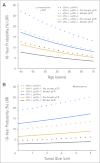Predictors of locoregional recurrence after neoadjuvant chemotherapy: results from combined analysis of National Surgical Adjuvant Breast and Bowel Project B-18 and B-27
- PMID: 23032615
- PMCID: PMC3488269
- DOI: 10.1200/JCO.2011.40.8369
Predictors of locoregional recurrence after neoadjuvant chemotherapy: results from combined analysis of National Surgical Adjuvant Breast and Bowel Project B-18 and B-27
Abstract
Purpose: The limited information on predictors of locoregional recurrence (LRR) after neoadjuvant chemotherapy (NC) has resulted in controversy about the optimal use of adjuvant radiotherapy and the timing of sentinel lymph node biopsy.
Patients and methods: We examined patterns and predictors of LRR as first event in combined analysis of two National Surgical Adjuvant Breast and Bowel Project (NSABP) neoadjuvant trials. NC was either doxorubicin/cyclophosphamide (AC) alone or AC followed by neoadjuvant/adjuvant docetaxel. Lumpectomy patients received breast radiotherapy alone; mastectomy patients received no radiotherapy. Pathologic complete response was defined as the absence of invasive tumor in the breast. Multivariate analyses were used to identify independent predictors of LRR. The primary end point was time to LRR as first event.
Results: In 3,088 patients, 335 LRR events had occurred after 10 years of follow-up. The 10-year cumulative incidence of LRR was 12.3% for mastectomy patients (8.9% local; 3.4% regional) and 10.3% for lumpectomy plus breast radiotherapy patients (8.1% local; 2.2% regional). Independent predictors of LRR in lumpectomy patients were age, clinical nodal status (before NC), and pathologic nodal status/breast tumor response; in mastectomy patients, they were clinical tumor size (before NC), clinical nodal status (before NC), and pathologic nodal status/breast tumor response. By using these independent predictors, groups at low, intermediate, and high risk of LRR could be identified. Nomograms that incorporate these independent predictors were created.
Conclusion: In patients treated with NC, age, clinical tumor characteristics before NC, and pathologic nodal status/breast tumor response after NC can be used to predict risk for LRR and to optimize the use of adjuvant radiotherapy.
Conflict of interest statement
Authors' disclosures of potential conflicts of interest and author contributions are found at the end of this article.
Figures





Comment in
-
Using chemotherapy response to personalize choices regarding locoregional therapy: a new era in breast cancer treatment?J Clin Oncol. 2012 Nov 10;30(32):3913-5. doi: 10.1200/JCO.2012.44.4539. Epub 2012 Oct 1. J Clin Oncol. 2012. PMID: 23032624 No abstract available.
-
Should response to preoperative chemotherapy affect radiotherapy recommendations after mastectomy for stage II breast cancer?J Clin Oncol. 2012 Nov 10;30(32):3916-20. doi: 10.1200/JCO.2012.44.3358. Epub 2012 Oct 1. J Clin Oncol. 2012. PMID: 23032626
-
Oncology scan--breast cancers.Int J Radiat Oncol Biol Phys. 2013 Apr 1;85(5):1151-2. doi: 10.1016/j.ijrobp.2013.01.007. Int J Radiat Oncol Biol Phys. 2013. PMID: 23523000 No abstract available.
-
[Prognostic factors for locoregional recurrence after neoadjuvant chemotherapy. Results of a combined analysis from NSABP B-18 and B-27].Strahlenther Onkol. 2013 Jul;189(7):594-5. doi: 10.1007/s00066-013-0350-1. Strahlenther Onkol. 2013. PMID: 23748232 German. No abstract available.
References
-
- Recht A, Gray R, Davidson NE, et al. Locoregional failure 10 years after mastectomy and adjuvant chemotherapy with or without tamoxifen without irradiation: Experience of the Eastern Cooperative Oncology Group. J Clin Oncol . 1999;17:1689–1700. - PubMed
-
- Katz A, Strom EA, Buchholz TA, et al. Locoregional recurrence patterns after mastectomy and doxorubicin-based chemotherapy: Implications for postoperative irradiation. J Clin Oncol . 2000;18:2817–2827. - PubMed
-
- Wallgren A, Bonetti M, Gelber RD, et al. Risk factors for locoregional recurrence among breast cancer patients: Results from International Breast Cancer Study Group Trials I through VII. J Clin Oncol . 2003;21:1205–1213. - PubMed
-
- Taghian A, Jeong JH, Mamounas E, et al. Patterns of locoregional failure in patients with operable breast cancer treated by mastectomy and adjuvant chemotherapy with or without tamoxifen and without radiotherapy: Results from five National Surgical Adjuvant Breast and Bowel Project randomized clinical trials. J Clin Oncol . 2004;22:4247–4254. - PubMed
-
- Effects of radiotherapy and surgery in early breast cancer: An overview of the randomized trials—Early Breast Cancer Trialists' Collaborative Group. N Engl J Med . 1995;333:1444–1455. [No authors listed] - PubMed
Publication types
MeSH terms
Substances
Grants and funding
LinkOut - more resources
Full Text Sources
Other Literature Sources
Medical

